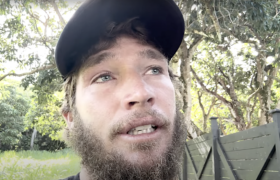Dazzling Sumba resort Nihiwatu best hotel in the world say readers of Travel + Leisure magazine…
The times are a-changing. Or they’ve changed. And it ain’t necessarily bad, at least if your credit card glows.
A few days ago, Travel + Leisure magazine announced that its readers had voted the Nihiwatu resort on Sumba, where clifftop villas overlook a sizzling lefthander which the resort claims exclusive rights to, the best hotel in the world.
It ain’t cheap, of course, but what price the sublime? The five-bedroom estate is $US12,000 a night in peak season while a starter villa is $US1500, inclusive of all food, yoga, wifi, but not, uh, surfing, which is limited to ten surfers.
Let’s examine the rate sheet.
“All surf slots are charged at USD100.00++ per day. A maximum of 1 surf slot per villa applies. If our guests are surfers we need to know how many will be surfing at the time of paying the deposit. Adjustments will be made to invoices for additional surfers according to your response. The above rate is subject to 11% government tax & 10% service charge and is non-commissionable. Please note that only registered surfers will be allowed to surf. These will have received a confirmation from the Boathouse time prior to their arrival, confirming their paid surf slot.”
How’s that Mastercard feeling? A little warm in your hands?
Study the wave, here.
Claude and Petra Graves set up Nihiwatu in 2000 before selling to American entrepreneur Chris Burch and South African hotelier James McBride in 2012. After renovations last spring, Nihiwatu was visited by Travel + Leisure magazine‘s Peter Jon Lindberg, who wrote:
“I spent my week in Sumba in a state of suspended bliss, orbiting among infinity pools, natural mud baths, waterfall-fed swimming holes, glowing valleys full of rice paddies, misty mountaintop villages straight out of Tolkien, and a beach that looked as if it were airbrushed on the side of a van.
That beach is spectacular, with or without the left-hand break, and one can easily see why the Graveses pitched their tent here. It can’t have changed much in the 27 years since: every morning I’d walk the mile and a half to the end, and every morning mine were the only footprints.
Nihiwatu’s redesign—by the Bali firm Habitat 5—finds a winning balance between refined and raw. Guest villas allude to traditional Sumbanese homes, with steeply pitched thatched roofs and massive kasambi tree trunks for support columns. Sumbanese ikat tapestries and black-and-white photos of local villagers hang on ocher stone walls. Wide-angle windows overlook lush gardens and the sea beyond.
Local touches show up everywhere: bathroom sinks are hewn from slabs of roughly carved stone; wardrobes are fashioned from coconut wood. The space is natural where you want it to be, sleek where you need it—as in the seamless glide of sliding glass doors; the light switches that glow in the unfamiliar dark; or the straw paddle fan that swirls inside, not outside, your monumental canopy bed. Most striking of the new villas: the Kanatar Sumba Houses, where an outdoor shower is magically cantilevered off the second floor. All the other outdoor showers went home and cried.
Ninety-eight percent of the staff are from Sumba. Like most guests, I was assigned a butler, a jovial Sumbanese man named Simson, who arrived at 7 a.m. every morning bearing breakfast—papaya, rambutan, watermelon juice, house-made yogurt, Sumba coffee. (The foodhere is terrific, highlighting the bright, fresh flavors you crave in the tropics.) One morning Simson was limping because a scorpion had bitten him on the toe back home. “I didn’t check before putting on my sandals!” he said, as if it were his fault, not the scorpion’s. He quickly added that one seldom encounters them at Nihiwatu.
Scorpions or no, I can’t remember a resort on any island that I’ve liked more than Nihiwatu. And while it is clearly not for everyone—there are no golf carts to whisk guests around— I can’t imagine what sort of crank wouldn’t fall for the place.
As they reach out to a broader clientele, Burch and McBride are determined to honor Nihiwatu’s commitment to the island. To this day, all profits from the resort go to the Sumba Foundation. They’ve even added an on-site “Guru Village,” where doctors stay for free in exchange for volunteer work. During my visit, a team of Australian eye specialists was in residence; they spent their mornings surfing and afternoons performing cataract surgeries in local clinics.
Of course there’s an inevitable dissonance between Sumba’s privation and Nihiwatu’s privilege, between a subsistence-level economy and a butler-staffed resort. Perhaps that’s why so many guests are compelled to support the foundation and, not least, to visit Sumbanese villages. To do so is to realize how unique— and symbiotic—the relationship is between Nihiwatu and the island it calls home.”
Did you, like me, laugh a little at the reference to the butler? “…a jovial Sumbanese man named Simson… one morning Simson was limping because a scorpion had bitten him on the toe back home.”
Oh, poor Simson, the damn native, paid to be jovial, even when he’s seized with poison!
Watch the promo video here.








